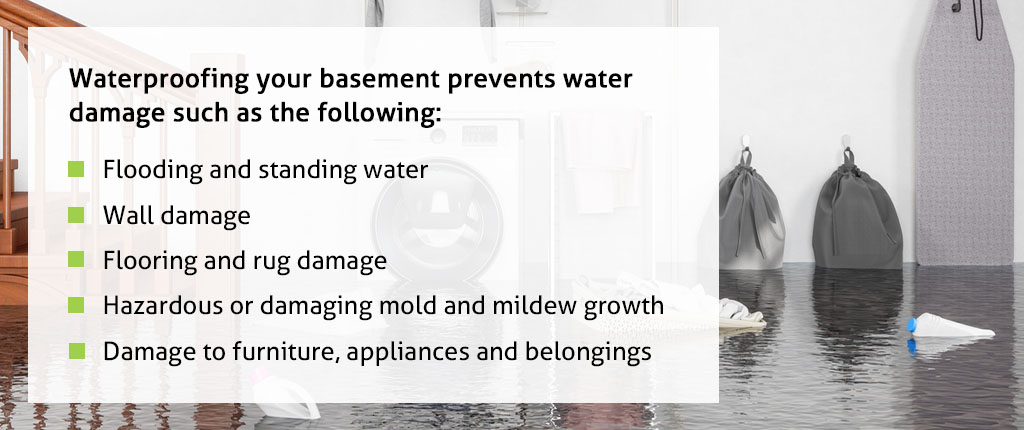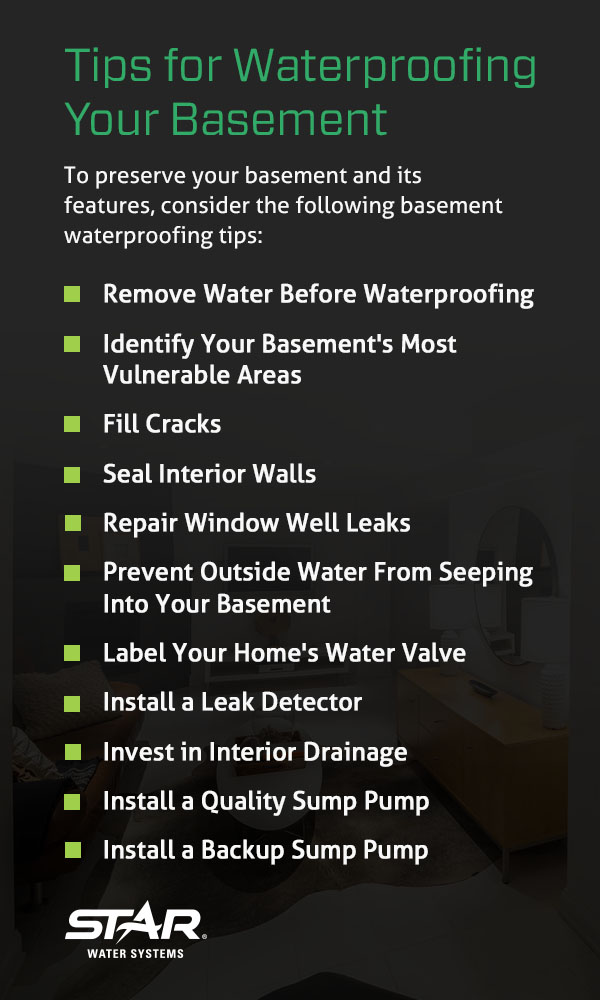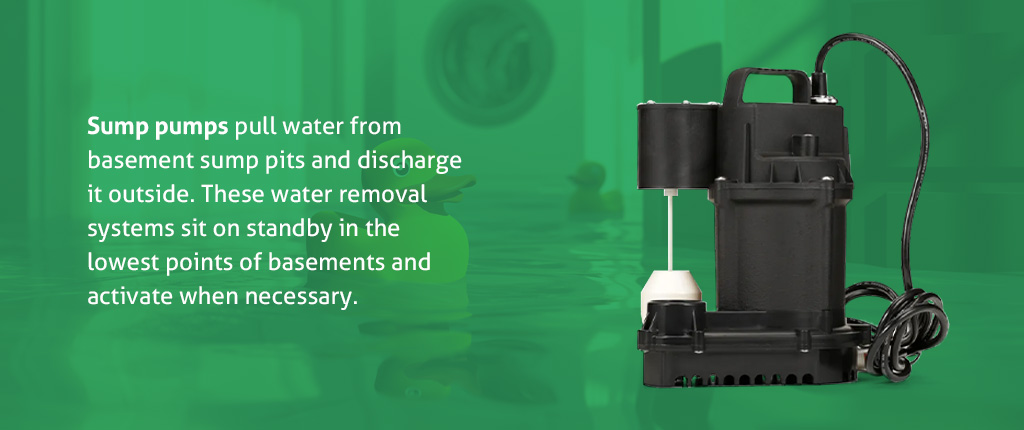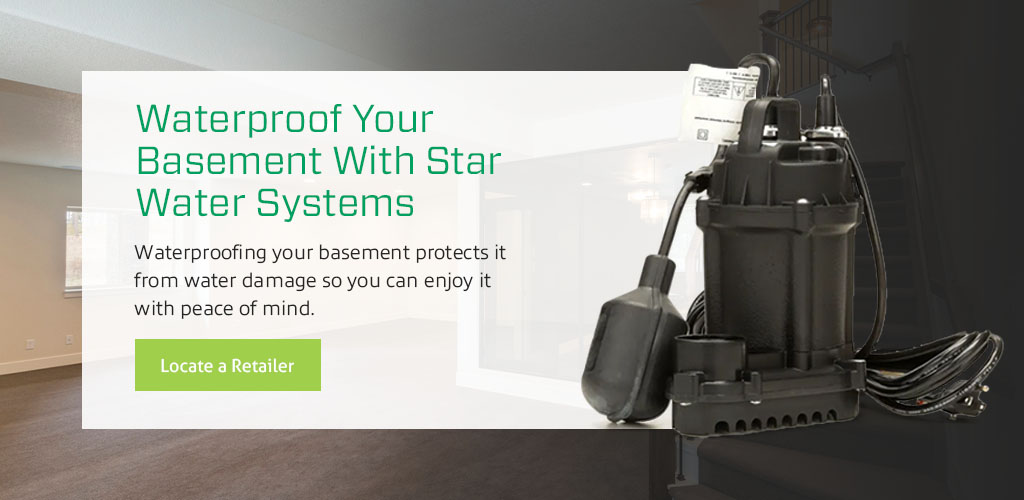Tips for Waterproofing Your Basement

Basement waterproofing is essential for any home. It protects your basement from leaks, floods and rising groundwater to prevent water damage and costly repairs. Whether your basement is a cozy gathering area, a comfortable home office, an entertainment room or an additional storage space, it’s an important part of your home — and it won’t do you much good if it’s underwater. Waterproofing your basement lets you relax and with the peace of mind that your belongings — and your wallet — are safe.
Various waterproofing strategies can provide the protection your basement needs in the event of leaks, flooding or foundation cracks. Filling cracks, sealing your basement walls and installing a quality sump pump system are some of the most effective ways to prevent water damage in your home.

Why You Should Waterproof Your Basement
Waterproofing protects your basement from water damage. Moisture can enter your home through foundation cracks or during heavy rain, snow and ice melt and rising groundwater. Waterproofing your basement prevents water damage such as the following:
- Flooding and standing water
- Wall damage
- Flooring and rug damage
- Hazardous or damaging mold and mildew growth
- Damage to furniture, appliances and belongings
Whether your basement is currently in good shape or seems to take in water frequently, taking steps to protect it now is important because leaks can happen at any time.
A basement can be a fantastic space when you maintain it well. Some homeowners transform their basements into quiet offices, while others use them as gaming rooms or secondary living areas. Some use their basements for storage, gyms or guest bedrooms. A basement entertainment space may hold valuable items such as televisions, computers, pool tables and couches. When you waterproof your basement, you’re taking steps to protect your belongings and investment.
No matter how you use your basement, it’s an important part of your house. It’s the strong foundation supporting your home’s structure, so protecting it helps preserve your home’s value, keeps your upper floors in good condition and prevents costly repairs.
Tips for Waterproofing Your Basement
Understanding how to waterproof a basement is essential if you own a home. Construction companies work hard to build homes with quality foundations that keep water out, but homeowners still need to take steps to protect their basements from water intake. To preserve your basement and its features, consider the following basement waterproofing tips:
Remove Water Before Waterproofing
Remove any standing water from your basement before waterproofing it. Working in a wet basement is dangerous and presents the risk of electrocution or electric shock. If you notice any flooding or water puddles in your basement, turn the basement’s power off and use a cord extending from your home’s upper level to remove the water with a utility pump.
Using a pump lets you transfer the water to the yard’s surface with a garden hose. Once you remove all of the water from your basement and let the area dry, you can begin inspecting and waterproofing.
Identify Your Basement’s Most Vulnerable Areas
Identifying areas that are most vulnerable to water intake lets you proactively address your basement’s water issues at the source. Concrete is a porous material, so checking your walls for water streaks can help you identify areas that need attention. Streaks indicate where water leaks into your basement, and they typically appear in the following areas:
- Cracks in the wall
- Window corners
- Between mortar joints in walls made of cement blocks
- Areas where pipes enter or exit the basement, such as sewer pipes or water-supply lines
You may also find your basement’s wall surfaces are damp or wet. It’s important to perform a condensation test to determine whether the moisture comes from outside or inside the basement. You can perform a condensation test with the following steps:
- Use a rag or cloth to dry a section of the wall.
- Use duct tape to secure a square, 1-foot piece of aluminum foil to the area.
- Wait 24 hours.
- Peel the foil off and feel the side that was touching the wall.
If the foil’s underside is wet, you can assume outside water is seeping into your basement walls. If its underside is dry, you can assume the condensation is originating from inside your basement. This could mean it’s coming from a basement shower or could indicate condensation is coming from your basement floor. Once you know where water is sneaking into your basement, you can fix and waterproof its most vulnerable spots effectively.

Fill Cracks
You may spot some cracks in your basement walls when inspecting. The bottoms of basement walls commonly crack due to the way homebuilders pour concrete.
Homebuilders first pour a flat base made of reinforced steel and concrete to support the walls they later pour onto the hardened base. This standard homebuilding procedure can form a weak foundation spot between the footing and wall, and weak foundation spots can develop cracks as the foundation shifts and settles. Lateral soil pressure can also contribute to developing cracks.
You can fill cracks with hydraulic cement, which expands and sets quickly. Follow the product packaging’s mixing and application instructions before repairing any cracks. Hydraulic cement typically forms a putty consistency when mixed with water, and it creates a watertight bond as it expands deep into crevices and cracks. It’s important to follow the product’s directions and use the cement quickly before it sets.
Seal Interior Walls
If you complete a condensation test and notice outside moisture is dampening the interior walls, you need to seal the walls. You can seal your basement’s interior walls with a basement sealer, such as a quality waterproof paint. Before applying a basement sealer, remove any existing paint from the walls to help the sealer adhere properly.
Once the walls are bare and dry, apply the sealer according to its packaging instructions. A sealer typically requires thick application so it fills every surface hole and crevice. It’s also essential to let each sealer coat dry before applying another layer. Pay extra attention to any safety guidelines, like ventilating the space before application.
Repair Window Well Leaks
Basement wall leaks often occur if a home’s original construction did not include a proper drainage installation under the well. Lack of proper drainage can let water pool around basement windows and leak inside. You may need to contact a professional to install a window well drainage system, or have them see if a simpler solution is possible.
Some homeowners might be able to dig below a window well area and place gravel beneath it to help rainwater disperse and prevent it from accumulating in the window well — it all depends on your unique property and structural needs.
Prevent Outside Water From Seeping Into Your Basement
You can also take additional measures to keep outside water away from your basement. Consider the following:
1. Flowerbeds
Removing flowerbeds and foundation plantings eliminates the need to water plants near your basement and reduces the amount of water accumulating near them. If you prefer to keep your gardens or flowerbeds, you can move them so you can water them a safe distance away from the home’s foundation.
2. Downspouts and Gutters
Ensure downspouts and gutters direct water away from the basement and make repairs if necessary.
It’s crucial to inspect your gutters each season and remove any debris like leaves and twigs. Cleaning your gutters prevents clogs and overflowing. If your gutters clog easily, install leaf guards to protect them from debris.
3. Grading
Grading your yard away from the home’s foundation can help direct water away from basement walls. To grade your yard away from your home’s foundation, you must form a slope that extends downward in the opposite direction of the foundation. This redirects water away from the foundation so it doesn’t flow into the basement.
Some homeowners choose to complete this task on their own using a wheelbarrow, rake and shovel, but it’s best to hire a professional landscaper for optimal results.
4. Outdoor Drainage
If your yard contains buried drain systems — known as French drains — inspecting them and clearing any blockages can help your yard drain water away from your home properly. If your yard lacks drainage drains, consider installing a French drain in areas where water directs water toward structures.
Label Your Home’s Water Valve
Appliances can flood your basement when they fail to drain properly, but labeling your home’s water shutoff valve can save your basement in an emergency situation. Make sure each household member knows where the valve is located and how to shut the water off. If anyone notices water collecting in the basement, they can shut off the water valve to prevent further flooding.
Install a Leak Detector
Water leak detectors can alert you when water leaks into your basement, which is especially helpful when you’re away from home and keeping an eye on the house. A whole-house water leak detector uses a wireless transmitter to detect leaks and shut your home’s water off if necessary. You can also consider installing a programmable leak detector, which can measure continuously flowing water and turn it off at a certain interval.
Invest in Interior Drainage
An interior drainage solution directs water to a drain channel where a sump pump removes it from your home. You can hire a foundation contractor to install an interior drainage system under the floor inside your basement walls and build new walls to hide the old ones. With this waterproofing system, any water that leaks through the old walls redirects to the basement’s sump pit, where a pump moves it outside.
Install a Quality Sump Pump
Taking measures to prevent water from entering your basement is important, but it’s even more crucial to have a system that protects your basement if water does seep in. One of the best ways to waterproof your basement is to invest in a quality sump pump.
Sump pumps pull water from basement sump pits and discharge it outside. These water removal systems sit on standby in the lowest points of basements and activate when necessary.
When excess water accumulates in a sump pit, it lifts a sump pump’s float switch once it reaches a certain level and turns the sump pump on. The sump pump then pumps water out of the basement safely to prevent water damage. You can choose from different sump pump options, such as:
- Submersible sump pumps: Submersible sump pumps take up little space because they sit below water in basement sump pits. They are efficient and powerful enough to remove water during heavy flooding, making them an excellent choice for homes vulnerable to inclement weather.
- Pedestal sump pumps: A pedestal sump pump’s motor sits above a basement’s sump pit while its base sits inside the pit. Pedestal sump pumps are ideal for homes outside of flood zones because they are designed to handle lighter water loads. They typically last longer and are easier to install than submersible sump pumps.

Install a Backup Sump Pump
A sump pump can effectively protect your basement from water damage, but a backup sump pump offers even more protection. Sump pump systems operate on electricity, so they only remove water from basements when homes have power. A backup sump pump offers protection if the primary pump malfunctions or loses power during an outage.
Installing a backup sump pump can provide you with even more peace of mind than having a single sump pump. In the event your primary pump stops moving water, a backup pump activates and takes over. You can install one of the following types of backup sump pumps in your basement:
- Battery-powered backup sump pump: A battery-powered backup sump pump operates on a battery, allowing it to store power and operate when needed.
- Water-powered backup sump pump: A water-powered backup sump pump operates on your home’s water supply. It can take over for your primary pump as long as your home has water, and it doesn’t require battery replacements.
If your home needs a primary and backup pump, you can also install a combination system. A combination system like the Basement Sentry Battery Backup Combo provides a high-performance primary sump pump and a battery-powered backup pump, so you can effectively protect your home without purchasing two separate systems.
Waterproof Your Basement With Star Water Systems
Waterproofing your basement protects it from water damage so you can enjoy it with peace of mind. Whether you use your basement for extra storage or a fun living space, your basement is important. Protecting it from water damage keeps your walls, flooring, furniture, appliances and belongings safe and helps you avoid costly repairs and replacements.
Filling cracks, sealing basement walls and repairing leaks, redirecting outside water away from your home’s foundation and installing a sump pump system are excellent basement waterproofing measures. Investing in a quality sump pump system is one of the most effective ways to protect your basement from water damage. While most waterproofing strategies prevent water from entering your home, sump pumps and backup sump pumps remove water in the event it does seep into your home.
Star Water Systems offers high-performing sump pump systems, battery-operated backup pumps, water-powered backup pumps and combination systems. Locate a retailer near you to protect your home with a quality sump pump system.
 Buy Now at Lowes
Buy Now at Lowes